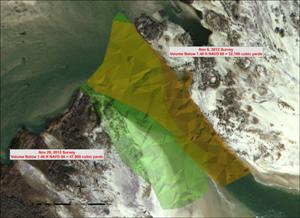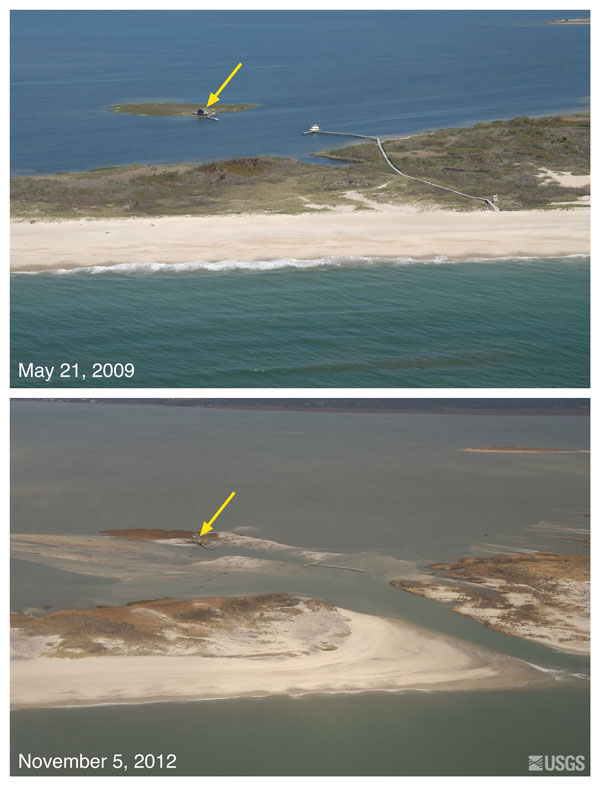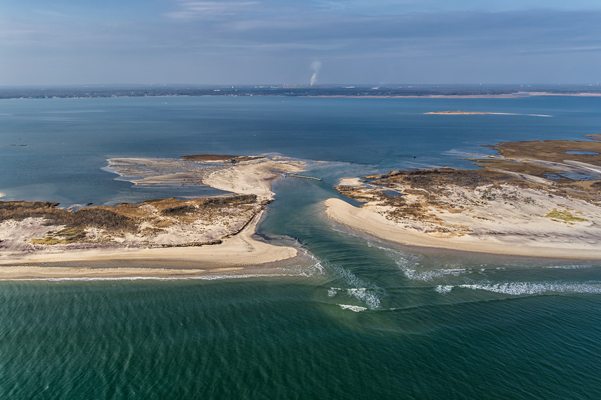Evaluation of a barrier-island breach created by Hurricane Sandy at Fire Island National Seashore, N.Y.—Continued.
Measurement of water velocities and depths on November 20, 2012 — methods and results
Objective:
On November 6 and November 20, 2012, and June 26 and November 13, 2013, U.S. Geological Survey (USGS) New York Water Science Center (NYWSC) personnel collected data to evaluate channel geometry, water velocity, and discharge of an open breach in the Federal Wilderness area of Fire Island National Seashore, N.Y. The breach resulted from major coastal flooding and overwash created by Hurricane Sandy on October 29, 2012. Data were collected using a Sontek1 M9 Acoustic Doppler Current Profiler (ADCP) with Real-Time Kinematic (RTK) Global Positioning System (GPS). Data were processed into Geographic Information System (GIS) for interpolation and display. The following information generally summarizes the measurement of water velocities and depths within the Wilderness breach on November 20, 2012.
Approach:
An initial series of transects was collected starting about 2 hours before ocean high tide on November 20, 2012. Data were collected perpendicular to flow through the breach beginning at 1016 Eastern Standard Time (EST) and ending at 1052 EST. The first set of transects was taken near the bayward side of the breach, with subsequent sets collected progressively closer to the seaward side of the breach. Discharge ranged from 2,900 ft3/s (cubic feet per second) during the beginning set of transects to 3,400 ft3/s during the final set of transects.
A second series of transects was collected starting about 3 hours before ocean low tide on November 20, 2012. Data collection began at 1542 EST and ended at 1623 EST. The first set of transects was taken near the bayward side of the breach; subsequent sets were collected progressively closer to the seaward side of the breach. Discharge ranged from 1,420 ft3/s during the beginning set of transects to 1,820 ft3/s during the final set of transects.
Additional data were collected along the approximate centerline and adjacent to the shores of the channel, as well as perpendicular to the flood tidal channels bayward of the former Great South Bay (GSB) shoreline, to map the inundated area of the breach. The overall mapped area includes data collected during discharge measurements of both incoming and outgoing tide conditions. The Digital Elevation Model (DEM) was created by plotting the depths of all data points collected relative to North American Vertical Datum of 1988 (NAVD 88) and interpolating the elevation of the bathymetric surface between these points.
The highest water surface elevation for all data collected on November 6 and 20, 2012 was 1.46 ft NAVD 88. This elevation was used to compute the volume of the breach throat as mapped from data collected on November 6 and again on November 20, 2012. The volume of the throat beneath the highest water surface elevation (1.46 ft NAVD 88) as represented by a Triangular Irregular Network (TIN) was 32,100 yd3 (cubic yards) on November 6 and 47,900 yd3 on November 20, 2012.
Collection of water levels within GSB adjacent to the breach is being be done with a modified USGS storm-tide sensor. This sensor, which normally collects 7 days of 30-second-interval data, has been reprogrammed to collect about 2 months of routine (6-minute-interval) tide-gage observations. Two Onset1 HOBO sensors were installed on November 6, 2012, to help ensure that at least one would remain fully operational through the planned, 2-month deployment. (Fortunately, both of these instruments ultimately collected just under 3 months of continuous record each.) Note that the East-sensor record was obtained from a position on the Old Inlet dock near the former barrier island shoreline, whereas the West-sensor record was obtained from the end of the dock nearest to Pelican Island. Sensor data can be viewed here (sensor deployment notes, East-sensor record [plot, data], West-sensor record [plot, data]) or downloaded in a zip-file.
Volume of the breach throat as mapped from
data collected on November 6 and again on
November 20, 2012. Click on image to enlarge.

1Use of trade, product, or firm names is for descriptive purposes only and does not imply endorsement by the U.S. Government.
Available products:
<< 3 of 7 >>
|
Aerial Photographs of Wilderness breach—Before & After Hurricane Sandy
Oblique aerial photographs of Pelican Island and Fire Island, New York. The
view is looking northwest across Fire Island towards Great South Bay. This
location
is within Fire Island National Seashore near Old Inlet—a very narrow
portion of the
island that has experienced breaching in previous large storms.
The island breached during
Hurricane Sandy, creating a new inlet. Despite the
breach, the fishing shack (yellow arrow) remained standing. Click on image to
enlarge.

Aerial view of the Wilderness breach at Old Inlet, looking from the Atlantic Ocean
to Great South Bay, on Saturday, November 10, 2012. NPS Photo/Abell.

Related Links:
Hurricane Sandy Information
|